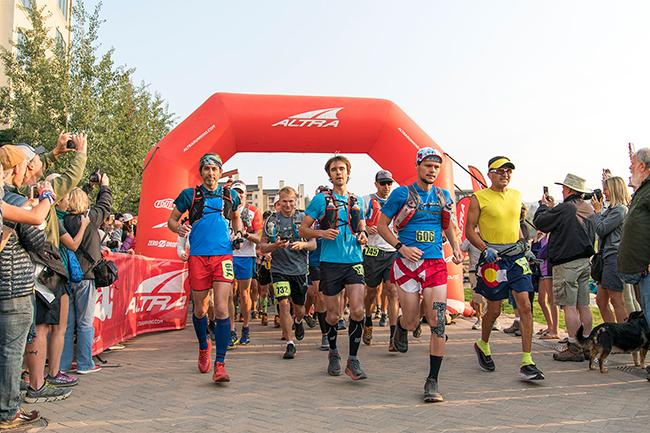Running is one of the great sports that keep you healthy no matter your age.
Usually, people Running with short distances of about 5km or 10km with runners running distances of about 42km is already great.
This is how people practice for international competitions and tournaments or to surpass themselves.
In addition to these short distances, we have to mention the super-long marathon with distances up to 50km, 100km even thousands of kilometers, and during the tournament time.
In this article, we will learn about this form of extremely long marathon and how we become someone who can run such long distances.

“Ultramarathon” or a super marathon is a rather harsh long-distance running, with a longer distance than a conventional 42km marathon.
This is probably the dream of most runners who just need to participate in the Ultramarathon and complete it is enough to win themselves and get praise, sometimes even admiration.
Most people will not dare to think of conquering this super marathon because most of the 5k, 21k, 42K running lessons are enough to make you feel dizzy.
Ultramarathon – Yet for those who have completed a marathon or a few times, they are often eager to explore their limits and new challenges.
So what if you are planning or aiming to conquer your first Ultramarathon event in your life?
This is a challenging but incredibly exciting goal. Make sure you memorize the training tips and super marathon tips to get ready to conquer the best race and explore what is the land behind the 42,195km border.
Now BellyFatZone invites you to refer to this article together!
So what is Ultramarathon?
Ultramarathon or super marathon is the name of any race held to exceed the standards of the 42 km (26 miles) marathon can be called a super marathon.
The number of races and the number of finishers has been increasing exponentially over the past 30 years.
Ultramarathons can be held on a normal track, on a trail, on a track, or even in the jungle or in the desert.
Races can be a point to point, like the Comrades Marathon in South Africa; in the wild, like the Niagara 100Km Canada; or on a circuit track, such as the famous Sri Chinmoy race each lap is 1 mile (1,609344 km) long and the participant has to run 1,300 laps or 2,092km.

The longest certified super marathon in the world called The Ultimate Ultra, held each fall in Sri Chinmoy, New York, is 1,300 miles (2,092 km) long.
There is also a Trans America Footrace, which is held each year, and participants must run for 64 consecutive days each day from Los Angeles to New York, over a length of nearly 3,000 miles (more than 4,800 km). , running about 45 miles (72 kilometers) a day on average.
The general rule of Ultramarathons is to allow runners to do their best.
This means that participants who are allowed to run can take a walk to drink or eat and even sleep for strength if the race is too long, such as races that last for days.
During such breaks, participants are not penalized, only if they take too much rest, they will be left behind.
Depending on the race that you attend, you will have to thoroughly learn both the maximum distance and maximum time required to compete. There are two popular types of Ultramarathons:
- Participants run within a certain distance
- A person runs as far as possible in a given amount of time.
Men and women can participate at all levels and there is no standard for race classification. However, the generally accepted standard at races is to run 50 km, 50 miles, 100 km, 150 km, 100 miles, 24 hours, 200 km, 48 hours, 200 miles, six days, 1,000 km, and 1,000 miles.
In fact, super marathon appeared very early, these sports only recently recognized by the International Amateur Sports Federation (IAAF).
In 1991, the IAAF officially recognized the 100 km race as the longest race recognized by many world sports organizations.
Although to participate in the super marathon requires runners to have very endurance and strong will, but the above challenges have not made people falter, but more and more people participate and New races appear with longer lengths and longer races.
According to Steve Diederich, who runs the Run Ultra website that lists the biggest super races in the world, there were only about 160 races in the world before the site was founded.
Currently on the Run Ultra listings more than 1,800 races – an increase of more than 1,000%. Another German website, DUV, also showed similar results with the number of races has increased by about 1,000% over the past 10 years.
Ultra Running magazine in the United States gives comparative figures for the North American region and also shows that the sport is growing very fast, with the number of races and runners reaching the finish from 1981 to Now it has been increasing steadily every year. For example, in 2003, nearly 18,000 people in North America completed the super race. In 2017, that figure was 105,000.
And in Asia also showed the number of races breaking out. Nic Tinworth, chief executive and race organizer in Hong Kong, said 10 years ago there were only six super races in the region, but now more than 60 races.
Many races around the world due to too many participants, such as the Ultra-Trail de Mont-Blanc in France and the Western States 100 in the United States, had to hold draws to limit the number of participants. bronze.
Diederich of the Run Ultra website is tasked with enrolling in the Marathon des Sables – one of the best known of the super races, runners must cross 156 miles in the Sahara desert.
Although the fee for one entry ticket is £ 4,250, Diederich says all tickets to the race sell out in minutes.
What's so attractive?
First of all, is the call of nature to take on an adventure and thereby gain rare life experiences.
Imagine being alone or a group of people walking through a large land with very few people walking in with a backpack on the shoulder with a water bottle and energy bars equal.

Next is that with the strength and the will to overcome your own limits, it must be pride.
One of the most famous and also challenging is the Marathon des Sables which lasts for six days and must pass 156 miles (250 km) through the Sahara desert in the south of Morocco. Many sections on this road cannot be run.
The sand here is so fine that the feet sink, making it hard for people to run. And even if it's a relatively easy track, April temperatures could reach over 100 degrees, and this means that no marathon des Sables track is free.
And although the track is very clearly drawn with more than 1,000 participants per year, it is still a dangerous race in the desert and three people have been killed on the track so far.
But no matter how high the challenges and difficulties are, more and more people are participating in transcendent races, because the common mentality of people is that everyone wants to prove that they are capable of doing things. The hardest.
What is the benefit of an “Ultramarathon” training?
Obviously, training for a long-term endurance race means you'll have to spend more time training but this also means a number of benefits that are well worth your effort. spent:
1 / Reduce the risk of disease
Sports in general and running here, in particular, helps reduce the risk of many chronic diseases like cancer and diabetes.
Of course, you don't have to start on a rigorous level of training right away to get these benefits – If you're a marathon starter, training for a shorter race is sure too. help prevent disease.
2 / Lose weight

Through long hours of running, your body is being burned with large amounts of calories; At the same time, the number of calories burned also depends on your weight.
According to Harvard Medical School, a person weighing 155 pounds (70,3069 kg) will burn 750 calories when running 6 miles (~ 10km) for more than an hour. At that same speed, doing an 18-mile (~ 29 km) run you can achieve a calorie burn of 2250 calories.
Of course, exercise is only half of the weight loss process, and runners trying to lose weight also need to further examine their eating habits.
Read more: How To Start Running To Get Fit Your Body When You're Overweight?
3 / Reduce anxiety
While the thought of training to run for more than 42km might cause anxiety in some, for many athletes, spending hours alone quietly on a trail may be what they need to reduce. reduce stress.
The moments of immersing in nature, getting the fresh air, and feeling the relaxation of exercise, are sometimes just what the body needs to create a calm and calm mind.
4 / Win yourself
Training and competing in a marathon challenge the body in a way most people would never even think of trying. The feeling of pride when you cross the finish line will bring you an enjoyable and proud experience.
What are the risks of doing Ultramarathon?

It is important to note that risks come with an extreme exercise regimen. Here are some of the risks you may encounter:
1. Heart problems
While many people are able to adapt to prolonged stress on the heart – and often with many improved cardiovascular health benefits – there is also a small subset of the over-exercising population that may increase the risk muscle with heart problems.
This is true for people who may have latent heart disease or a family history of heart problems.
2. Loss of muscle mass
Because running training in a super marathon is time-consuming, offers some endurance training possibilities. If you're not steadfast in strength training, you run the risk of losing some skeletal muscle mass (especially in the upper body).
Adding some simple weight exercises (like push-ups, planks, bird dogs, glute bridges, squat, and lunges) a few times a week or doing 1 to 2 weightlifting sessions weekly, can help reduce the risk of losing muscle mass.
3. Risk of injury
As you increase the duration and frequency of your training, it puts additional pressure on your body. This is especially true when you're running for the long run, where your fitness begins to decrease over time, leading to changes in muscle use and stride.
Using a progressive exercise plan will help reduce your risk of injury. However, depending on your physical level, weight, and ability to recover, trauma can still occur.
How to train for an Ultramarathon?

If you are new to running, consider hiring a running coach so you can come up with a training plan.
A good trainer can visualize your stamina, find the right hills or speeds for your body, and where to start the workout right for your current fitness level.
However, the core of the problem to complete a long-distance competition requires both physical and mental endurance. There are two main differences to consider when training for a super marathon compared to a standard marathon:
1. Terrain: Since most super marathons run on the trail, you should plan your training with lots of trail running experience.
2. Speed: Ultramarathon runners obviously run a lot slower than the fastest marathon runner. Usually, they tend to complete the first 42 km in about 3-4 hours. However, they still have close to 2 to 5 more marathon distances to conquer.
“Endurance, especially super tolerance, helps limit the damage you do to muscles”. “When we run 5,000 m and 10,000 m, we often talk about a certain speed to reach and maintain.
But running super long distances, you just have to try to finish the race ”. (Quoted from Mark Burnley, an endurance physiologist at the University of Kent in the UK)
If you decide to build your own workout regimen, here are a few tips:
1. Build your skills:
Before you start doing any race-specific training, you need to have a solid running skill in place. Most people should have at least a year of steady, solid running experience before they even think about training for a long-distance competition.
2. Build a training cycle:

Just as you plan your training out for any other race distance, the same applies to a super race.
Most 50K plans (a good place to start for long-distance runners) are around 16 to 20 weeks, building on the skills you already have. Usually, you should run at least 10 miles comfortably at the beginning of a particular exercise cycle.
3. Increased recovery time:
The goal is for the body to feel comfortable in exercise! Muscle pain and fatigue are inevitable consequences of super marathon training, but not a regular stretch.
In fact, we will feel whether we train the right way when every run we end up feeling excited instead of tired.
When you plan your workout cycle, be sure to include recovery weeks, also known as rest weeks.
4. Run regularly:
The recommended number of runs per week will vary based on your experience, age, goal, etc. – but generally, 4 to 6 runs per week are appropriate.
If we've done resistance and speed runs in the past, keep adding these exercises in your exercise program, but make sure your body has extra recovery time before and after your workout. to be ready for weekly runs.
The weekly running distance should be the same as for marathon training but should redistribute the running distance from day today.
5. Includes different running styles:
If you're working out 5 days a week, your runs might look like this:
- Monday – Easy to run
- Tuesday – Run on a hill or run fast
- Thursday – Easy Run
- Saturday – Long Run
- Sunday – Run recovery
Long runs should be about the same distance as long runs when practicing for a marathon. It should be noted that running a super marathon on hilly terrain usually takes longer than running a flat track at the same distance.
Marathon runs are suitable for 80km training but require about 2-3 additional runs of two consecutive long runs on Saturdays and Sundays every 2-3 weeks during the training period. peak training (This is called back-to-back, which means running on both Saturday and Sunday, without an interlaced break to endure high-intensity activity and get used to feeling tired – ND).
The length of the second-longest run should be about 1/2 or 3/4 of the length of the first day running (quoted from BoiDapChay)
Example: You can do a long-running on Saturday (more than 30km) and another long run on Sunday (20-25km) so you don't have to run more than 45km in one run.
As you can see, most of your runs should be at a comfortable, easy pace. This ensures you can get all the way you can, but won't tire your body too hard or increase your risk of injury.
6. Go long enough before your race:
Assuming you want to test your first 50K race, make sure you have enough time to train for at least 35 to 40km a few weeks before you enter the race.
This will ensure your body can handle 50km smoothly. You don't have to do the entire race track before the event takes place (though some championship athletes may choose to do so).
7. Relax before the event:
Lowers or cuts out the amount of exercise, helping your body reach the starting point with a feeling of refreshment. Most athletes relax for about 2 weeks before going to an event.
Read more: How To Improve Running Form Avoid Injury And High Efficiency?
Nutrition advise for Ultramarathon practitioners

As you prepare for this race, you are pushing your body to the limit physically and mentally. One of the most important things you can do to support your adaptive and restorative training is to focus on nutrition.
You should fine-tune your nutrition and hydration plan throughout your training schedule. create your own. Here are some basic guidelines
1. Eat a well-balanced exercise diet that integrates all three macronutrients: While some runners may adapt to a low-carbohydrate diet or a keto diet during training. Most will eat better with a diet that includes a variety of healthy carbohydrate sources, in addition to protein and fat.
These healthy carbohydrates include fruits, starchy vegetables, whole grains, some dairy products, and beans.
2.Drink enough water: This applies during your workout, but also every day. If you start a workout in a dehydrated state, you will most likely experience performance issues.
However, do not drink too much during long exercise. Drinking too much water while running can increase your risk of having a dangerous condition called hyponatremia or diluting sodium levels in the blood. Most athletes can correct themselves by drinking according to their thirst.
3. Eat before a long run: Your body burns both carbohydrates and stored fat during moderate-intensity exercise. Fuel your body by eating a high-carb meal about 1 to 4 hours before a long or intense workout.
For easy short runs, you don't need to do anything special – but in general, people notice better energy levels and less fatigue when they've eaten a good meal or snack. within a few hours of finishing the practice session.
4. Save energy in the long term: Your body does not have an infinite reserve of carbohydrates, so you will begin to have trouble when these reserves are depleted.
By adding carbohydrate-rich foods during exercise, you will help keep your muscles in constant energy.
5. Use the right nutrition to support recovery: After a stressful or prolonged exercise, try to eat a meal with both carbohydrates and protein within 30 to 60 minutes after finishing. This will help replenish your glycogen stores and initiate muscle repair.
However, recovery doesn't stop here. Think about the rest of the day! For example, foods like berries, sour cherry juice, and fish all have important nutrients that can aid recovery.
Choose suitable Ultramarathon

While this may seem as simple as searching the Internet for a marathon nearby, there are a few considerations that you will want to research more into when choosing your own:
1. Qualification
Keep in mind that some races may require qualifying runs, so make sure to review the standards before signing up and plan to spend plenty of time between your qualifiers and the official race.
2. Topographic map
Think about the terrain and height you will encounter. Consider the terrain near you that is available to practice and whether it will help you succeed.
3. Travel
Choosing a race at an attractive destination can be both a blessing and a drag. On the plus side, you can travel to a new place and experience it in a way that many others can't (on foot).
But entering a race can bring challenges, from delaying flights to changing your diet. Be sure to have a detailed plan for yourself and if you need to adapt to high altitudes or temperatures, then you will need to schedule your time earlier.
4. Time
Obviously, training for a super marathon is all about timing.
Make sure to choose a race with the right timing to give your body enough time to practice increasing your running distance scientifically and on schedule. Trying to train fast for a race could cause serious injury.
For example, for a 50K race, you need to train for about four months. Follow whatever training regimen is right for you. One option is a 16-week training plan for a trail marathon – follow it, repeat week 12, to form a 17-week training schedule for the 50K.
5. Supply track
Many trail races are in remote areas, so you'll need to make arrangements to camp or stay nearby. If it's a popular event, book in advance on an area or room to make sure you get a spot. Most races start early in the morning, so stay as close as possible.
Ultrarunning Tips for Newbies

Epilogue
Whether you've been running for years or are just intrigued by the idea of Ultramarathon events, it is important to be serious about your fitness and nutrition program.
One of the training mistakes we often make is that many beginners running super marathons often try to find a shortcut in the body's adaptation process by constantly challenging the limits of the body to end up. Department is trauma and exhaustion.
Always check with your doctor before starting your workout and allow plenty of time to prepare for your event!
View more:
- Zumba Exercises To Lose Belly Fat Incredible At Home For Busy People
- How to Do Burpees For Beginners? All You Need
- Morning Exercise Routine For Beginners – Mistakes You Need To Avoid To Be Effective
Hopefully, the information above has helped you to gain some more knowledge about “train for an ultramarathon”, and bring some small value to you. Please share this article if you feel it is useful. Thanks!






